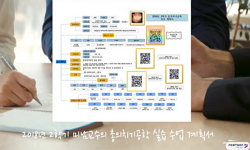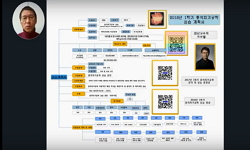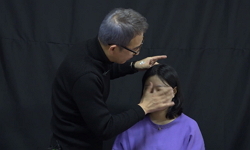본고는 이황의 「野池」와 조식의 「江亭偶吟」을 통해 이들이 지닌 상상력의 핵심과 그 문학적 전개를 살핀 것이다. 그 동안 이황과 조식이 여러 측면에서 비교 연구되었지만 이들의 사상...
http://chineseinput.net/에서 pinyin(병음)방식으로 중국어를 변환할 수 있습니다.
변환된 중국어를 복사하여 사용하시면 됩니다.
- 中文 을 입력하시려면 zhongwen을 입력하시고 space를누르시면됩니다.
- 北京 을 입력하시려면 beijing을 입력하시고 space를 누르시면 됩니다.

한국사상(韓國思想) : 문학(文學) ; 이황과 조식의 문학적 상상력, 그 동이(同異)의 문제 = Korean Literature : The similarities and Differences between Lee Hwang(李滉)`s and Jo Sik(曺植)`s Literary Imagination
한글로보기https://www.riss.kr/link?id=A75399476
- 저자
- 발행기관
- 학술지명
- 권호사항
-
발행연도
2007
-
작성언어
-
- 주제어
-
KDC
151.05
-
등재정보
KCI등재후보
-
자료형태
학술저널
- 발행기관 URL
-
수록면
7-44(38쪽)
- 제공처
- 소장기관
-
0
상세조회 -
0
다운로드
부가정보
국문 초록 (Abstract)
본고는 이황의 「野池」와 조식의 「江亭偶吟」을 통해 이들이 지닌 상상력의 핵심과 그 문학적 전개를 살핀 것이다. 그 동안 이황과 조식이 여러 측면에서 비교 연구되었지만 이들의 사상적 핵심을 창으로 하여 문학 전반을 검토한 것은 없었다는 점에 착안한 것이다. 본고에서 중요하게 다룬 「야지」와 「강정우음」은 당대부터 학자들에게 관심의 주요 대상이 되어왔다. 이 두 작품은 ``심``에 기반한 수양론을 시적으로 형상화하고 있다는 측면에서 동질성을 갖는다. 조선조 성리학자들의 제1화두였던 수양론은 인욕을 막고 천리를 보존하여 성인의 경계에 진입하자는 것이었다. 이황과 조식 역시 이 같은 노력을 성실히 하였고, 그 결과가 「야지」와 「강정우음」에 곡진히 드러나고 있었던 것이다. 두 작품에 동질성만 있는 것은 아니었다. 특히 수양의 방법론적 측면에서는 상당한 이질성을 지니고 있었던 것으로 확인된다. 이황이 본연의 마음을 의미하는 ``연못`` 주변에서 현실과 ``차단``된 일정한 공간을 확보하면서 ``恐``의 태도로 천리를 보존하려고 한 데 비해, 조식은 바다와 연못 사이에 있는 ``강``에서 끊임없는 현실의 ``간섭``을 경험하면서 ``憎``의 태도로 강력히 인욕을 제거하고자 했다. 이것은 각기 미발 상태의 존양과 기발상태의 성찰이라는 상대적 강조가 만들어낸 결과라 하겠다. 이황과 조식의 상이한 문학적 상상력은 사물접근법의 상이를 의미한다. 이황이 사물을 보면서 이치를 살피고자 했다면, 조식은 사물을 보면서 세상을 살피고자 했던 것이다. 이것은 각기 觀物察理와 觀物察世로 요약이 가능하다.
다국어 초록 (Multilingual Abstract)
This study discussed Lee Hwang`s and Jo Sik`s core imaginations and how the imaginations developed in their literature by examining Lee Hwang`s 「Yaji(野池)」 and Jo Sik`s 「Kangjeongueum(江亭偶吟)」. So far, Lee Hwang and Jo Sik have been c...
This study discussed Lee Hwang`s and Jo Sik`s core imaginations and how the imaginations developed in their literature by examining Lee Hwang`s 「Yaji(野池)」 and Jo Sik`s 「Kangjeongueum(江亭偶吟)」. So far, Lee Hwang and Jo Sik have been compared in various ways in many researches, but no research has been conducted to examine their overall literature on the basis of their core ideology. 「Yaji」 and 「Kangjeongueum」 heavily discussed in this study have attracted lots of attention from scholars since their publication. The two works are similar in that both poetically embodied the theory of cultivation based on mind. The theory of cultivation, the primary subject of conversation among Neo-Confucian scholars in the Joseon dynasty, aimed at encouraging people to block human desires and preserve the principle of Heaven in order to live the life of a sage. Lee Hwang and Jo Sik also made such efforts, which is well manifested in their works, 「Yaji」 and 「Kangjeongueum」. The two works showed differences as well. Especially, in the methodological aspect of cultivation, their difference was prominent. Lee Hwang tried to preserve the principle of Heaven with an attitude of reverence while securing some space isolated from the reality around the ``pond`` that signifies the innate mind. On the other hand, Jo Sik tried to strictly restrain human desires with an attitude of abhorrence while experiencing endless interruptions of the reality in the river between the sea and the pond. These differences were attributed to the fact that Lee Hwang and Jo Sik put relative emphasis on the cultivation of virtues in pre-development state and introspection in post-development state respectively. The difference between the two scholars` literary imagination indicates they took a different approach to things. While Lee Hwang tried to understand the reason of things, Jo Sik pursued to understand the world through things. These can be summarized ``Kwanmulchally(觀物察理)`` and ``Kwanmulchalse(觀物察世)`` respectively.
동일학술지(권/호) 다른 논문
-
한국사상(韓國思想) : 철학(哲學) ; 명재(明齋) 윤증(尹拯)과 덕촌(德村) 양득중(梁得中)의 학문(學問) 교유고(交遊考)
- 한국사상문화학회
- 이상성 ( Sang Sung Lee )
- 2007
- KCI등재후보
-
한국사상(韓國思想) : 철학(哲學) ; 조선조 삼청전(三淸殿)의 건립 배경과 터[址]의 위치에 관한 고찰
- 한국사상문화학회
- 유병래 ( Byung Rae You )
- 2007
- KCI등재후보
-
한국(韓國)의 문화(文化) : 남북 규범어의 통합 방안
- 한국사상문화학회
- 한용운 ( Yong Un Han )
- 2007
- KCI등재후보
-
한국(韓國)의 문화(文化) : 『금강경언해』의 번역에 관련된 몇 가지 문제
- 한국사상문화학회
- 김무봉 ( Mu Bong Kim )
- 2007
- KCI등재후보




 KISS
KISS







